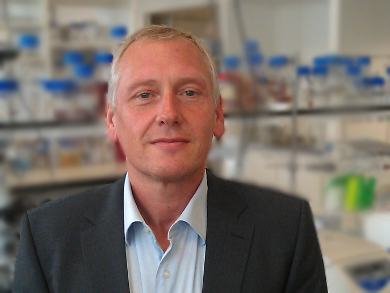Dr. Meghan Campbell, Editor-in-Chief for ChemBioChem, talks to Professor Jason Micklefield, University of Manchester, UK, about his article on the design of a new halogenase enzyme that could prove useful for the halogenation of aromatic molecules. The work was recently published in ChemBioChem.
In your article, you report the first X-ray crystal structure of a tryptophan 6-halogenase (SttH), and the first clear example of how regiocomplementary halogenases can be created from a single parent enzyme. Which part of this study proved the most challenging?
The mutagenesis of SttH and the screening of mutants with various substrates was slow and laborious. Consequently, identifying mutations that switch the regioselectivity of the enzyme whilst maintaining good catalytic activity was the major challenge. We were fortunate, in that the X-ray crystal structure of SttH allowed us to identify the key residues that effect the regioselectivity of halogenation, which proved invaluable in guiding mutagenesis strategies.
Why did you choose to employ X-ray crystallography for this project?
There is high sequence similarity between SttH and the other natural tryptophan halogenases which exhibit different regioselectivity. Consequently, we anticipated that minor structural differences in the active sites of these enzymes would be responsible for the different regiochemical outcomes observed.
To identify these subtle structural differences, it was necessary to obtain an accurate high-resolution X-ray crystal structure of SttH. We are also fortunate to collaborate with excellent crystallography colleagues in our institute.
What was the inspiration for this study?
Many valuable natural and synthetic products, including leading pharmaceuticals, are halogenated organic compounds. In addition, haloaromatics are widely-used precursors in synthesis and can be derivatized using a wide range of transition metal catalyzed cross-coupling reactions.
We are interested in the possibility of engineering and exploiting halogenase enzymes to develop alternative methods for halogenating aromatic scaffolds. In addition to using these enzymes as biocatalysts in vitro, we are also interested in developing these enzymes for inclusion into new biosynthetic pathways in vivo.
What are some of the advantages to using enzymes for catalysis over more traditional methods?
The traditional chemistry used to prepare haloaromatic compounds often lacks regiocontrol and uses toxic reagents. The exquisite regioselectivity and benign, aqueous operating conditions of halogenase enzymes make them a potentially useful alternative for halogenation of aromatic scaffolds. In addition to this, the halogenases can be used both inside and outside of cells.
Do you see enzymatic halogenation becoming a viable option for halogenation reactions on an industrial scale?
Halogenases are used to produce large quantities of halogenated biosynthetic products in vivo via fermentation. For example, production of the antibiotics vancomycin and griseofulvin is dependant on halogenase enzymes, like SttH, and can be achieved on an industrial scale in high yields.
However, halogenases, like many enzymes from secondary metabolism, are slow and less efficient than enzymes from primary metabolism, presumably because they have not been under the same evolutionary pressure. It will, therefore, be necessary to improve the catalytic activity of halogenases for synthetic applications in vitro. Some progress has already been made using directed evolution and other techniques, but there is still some way to go before halogenases can be used as stand-alone enzymes in industry.
How will you follow up on this discovery?
In separate studies, we have also shown that halogenases, including SttH, are compatible with other bio- and chemo-catalysts, which can lead to further derivatization of aromatic compounds via cascade reactions. We are also exploring the biocatalytic and biosynthetic potential of other types of halogenase enzymes from fungal origins, as well as ways of improving the catalytic activity and substrate specificity of these enzymes using similar structure-guided approaches. Hopefully, some of this work will be published soon.
How do you see the future of chemical biology? How will it differ from that of chemistry or biochemistry?
Chemical biology appears to have become more focused on pharmaceutical end goals, particularly the development of synthetic ligands for therapeutic targets, which is, of course, very important. However, I think chemical biology covers much more than this and we should endeavor to maintain a broad remit.
In my opinion, chemical biology depends on training interdisciplinary scientists; individuals who are knowledgeable and competent in both chemical and biological skills. The presence of individuals who are equally comfortable cloning genes and purifying proteins as they are with organic synthesis, for example, is what sets the chemical biology lab apart from the traditional chemistry, biochemistry, or biology activities.
- A Structure-Guided Switch in the Regioselectivity of a Tryptophan Halogenase Enzyme.,
Sarah Ann Shepherd, Binuraj R. K. Menon, Heidi Fisk, Anna-Winona Struck, Colin Levy, David Leys, Jason Micklefield,
ChemBioChem 2016.
DOI: 10.1002/cbic.201600051




